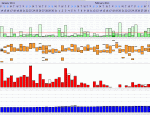Hi Todzo, yes that's a very interesting thought. I'm not too sure about the 2nd part "until the first diaphram muscle pull against your willfully closed airway", but that urge to breathe is often over 10 seconds especially if my mind is focused on something else. When i do the experiment and think about breathing, then there's an urge to breathe at about the 7-9 seconds mark, but i'm quite sure that normally it can go over 10 seconds when i'm concentrating on something.Todzo wrote:Hi padster!padster wrote:Hey Liz, it's been over 2 weeks and the Centrals are a little lower, between 1 and 3, when they were between 2 and 5 previously, but even after using a 4cm CPAP setting, the OSAs are still almost non-existent, which is why i posted a new thread asking about whether such a low pressure can fully knock out OSAs in viewtopic/t80934/Is-it-possible-for-4cm ... -OSAs.htmlLizistired wrote:Have you made any progress?
Not sure what else to do. I thought i would try this new setting for a week or two before reporting back, and it appears there's a marginal improvement, but the overall situation of OSAs+No-Centrals in the sleep study vs Centrals+No-OSAs while on CPAP is still puzzling. My last resort is to have a full sleep study done with EEG to see if it can provide a clearer picture.
Try this simple experiment. While at your desk after doing something that you love to do for at least five minutes (look at favorite pictures or whatever) breath out gently and then stop and count seconds - - until you feel the urge to breath --- until the first diaphram muscle pull against your willfully closed airway. If time to urge to breath is over ten seconds and if time to diaphram muscle pull is longer than 15 seconds then consider that what you are dealing with may be simply a more healthy chemoreflex system that the average CPAP user. "Centrals" as you call them here are simpy times when you do not breath at night even though your airway is clear. It is not necessairly a bad thing at all. Indeed, it may be an indicator of health.
Simply, something to think about,
Todzo
For example, when in bed and with the CPAP running, before falling asleep, there are quite a few times when i feel the mask vibrating a little (i presume that's when its approaching 10 seconds or when the gush of air is about to kick in) ... and i find myself thinking, hey, i don't feel like i need to breathe yet, so why's this machine getting all frantic. So, i guess i may have a tendency to hold my breath or take longer than average pauses between breaths at times.
I think i also have a shallow breathing habit, where i only find myself taking deep breaths when i consciously think about it. Now, together with this shallow breathing, when i breathe out, it can be quite slow and prolonged, to the point where in the final few seconds of the exhale, there can be very little air coming out ... and i'm wondering whether the CPAP machine is even able to detect these final few seconds when i exhale very lightly .... because if it can't, and i add these 2-4 seconds onto the 5-7 seconds when i stop breathing in between breaths, it may start to account for the Clear Airway events i'm getting. Furthermore, if we factor in another few seconds of extremely light/shallow breathing in after the pause in between breaths, i'm seriously wondering if this could be the cause of my Clear Airway events.
Does anyone know if there has there been any discussion or analysis on whether (extremely) shallow breathing could be causing Clear Airway events for CPAP users?











